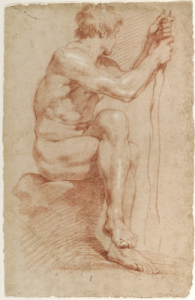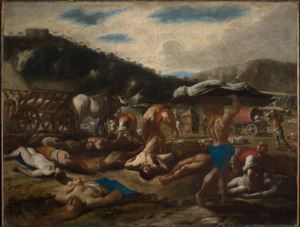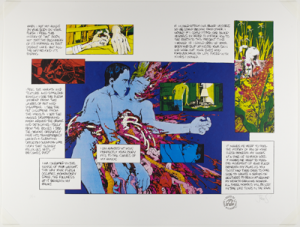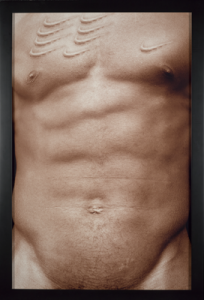Discussion goals: By placing each work in a historical context, and by considering its technique and materials, students will be encouraged to relate it to an artist’s interest in anatomy and proportion, representations of bodies as healthful or suffering, and relationships between the depicted bodies and the viewer’s body.
Gian Lorenzo Bernini, Seated Male Nude

Seated Male Nude
ca. 1618–24
Red chalk heightened with white chalk on buff laid paper
42.2 x 27.2 cm (16 5/8 x 10 11/16 in.)
frame: 61.3 x 45.6 x 3.2 cm (24 1/8 x 17 15/16 x 1 1/4 in.)
Museum purchase, Laura P. Hall Memorial Fund and Fowler McCormick, Class of 1921, Fund
2005-128
Bernini’s graphic oeuvre, which largely consists of quick sketches for sculptural and architectural projects, includes a handful of finished red-chalk life studies of muscular male nudes, later known as academies. These may have been made as demonstration pieces in the context of the informal life-drawing classes that Bernini is said to have staged in his studio. Modest in scale yet powerfully three-dimensional in effect, this relatively early example displays Bernini’s ability to convey theatrical monumentality on paper. Through his economical handling of red and white chalks, surface and contour are expressively transformed by flickering light and surrounding atmosphere.
Conversations prompts
Describe the pose of the figure. Which traits does Bernini seems particularly interested in capturing?
What are some of the specific effects of the medium of red chalk on paper? How do they complement the representation of the nude figure?
Carlo Coppola, The Pestilence

Naples
The Pestilence of 1656
Oil on canvas
76 x 99 cm (29 15/16 x 39 in.)
frame: 98 × 119 × 4 cm (38 9/16 × 46 7/8 × 1 9/16 in.)
Museum purchase, Caroline G. Mather Fund
y1963-36
Carlo Coppola’s The Pestilence of 1656 is an exceptionally grim portrayal of Naples’s most devastating bout with the black death. The narrative unfolds on a metaphorical battlefield covered with bodies and devoid of any suggestion of divine intercession in aid of the sick. Poignant details include an infant nursing from his dead mother’s breast, and a figure with a cloth covering his face—a detail speaking to the odor of the decaying bodies as well as the fear of contracting the plague through putrid air, a false but widespread contemporary belief.
Conversation prompts
What are the relationships between the living and the sick or dead in this painting?
How did Coppola use contrasts in light and color to move the viewer’s gaze across the composition?
What are some of the differences in the ways Coppola depicted the bodies of the living versus the bodies of the dead?
Romberger and Wojnarowicz, untitled, 1993

text by David Wojnarowicz, American, 1954–1992
untitled, 1993
Screenprint
69.4 x 91.5 cm. (27 5/16 x 36 in.)
mat: 76.2 x 101.6 cm. (30 x 40 in.)
Museum purchase, anonymous gift
x1993-211
Working in New York City’s East Village during the late 1980s—when the newly defined AIDS epidemic was exacerbated by federal neglect and societal prejudice—David Wojnarowicz depicted moments often silenced by homophobia and fear. Before his death from an illness related to the virus, Wojnarowitz’s multimedia work engaged in a radical honesty that drew on intimate experiences to pry open legal and social exclusions. In 1986, the cartoonist James Romberger began working with Wojnarowicz on a graphic memoir of Wojnarowicz’s life, from his years as a homeless teenager to his struggles with AIDS; Wojnarowicz died before they could complete the book together. Romberger continued to work on the manuscript, published in 1996 as 7 Miles a Second. In this screenprint of one of the layouts, an explosion and fusion of bodies manages to feel horrific and also intimate. Likewise, Wojnarowicz’s autobiographical writings convey both rage and vulnerability: “It makes me weep to feel the history of you of your flesh beneath my hands at a time of so much loss . . . All these moments will be lost in time like tears in the rain.”
Conversation prompts
What effect does the comic book-like format of the scenes have on the viewer’s reading? How do the text and images relate to one another? In what order do you read the scenes?
Is this a hopeful image? Why or why not?
How does the autobiographical nature of this work inform your reading of the relationship between caregiver and the ill?
Hank Willis Thomas, Scarred Chest

Scarred Chest, from the series B®anded
2003
Chromogenic print
101.6 × 76.2 cm (40 × 30 in.)
frame: 111.8 × 77.5 cm (44 × 30 1/2 in.)
Museum purchase, Fowler McCormick, Class of 1921, Fund
2016-379
In Scarred Chest, the muscled torso of a black man fills the frame. Although he is seemingly in perfect physical shape, his pectoral muscles are marred by nine Nike swoop-shaped scars. While these raised shapes are reminiscent of extant photographs of the latticework scars left by the lacerations of a slave-owner’s whip, Thomas is also referring to the historical punishment of branding runaway slaves, often on their chests or shoulders. This branding, like that used by Nike more than a century later, was meant to signal an identifiable product. Thomas inserted the scars onto his model’s body through digital manipulation, using the Nike logo as a means of calling attention to how slavery, sports, and African American history are entangled.
Conversation prompts
What effect do the scale of this work and its cropping have?
In superimposing scarification marks, what other images does Willis’s photograph call to mind?
Is this a powerful or susceptible body? Explain.
Sample Classes and Checklists
Elena Fratto, SLA368_HUM368_RES368_COM348: Literature and Medicine
Jõao Biehl and Amy Krauss, ANT235_HUM235: Medical Humanities
Alessandro Giammei, ITA 208: Introduction to Italy Today (The Body in Catholic Art)
Wallace Best: AAS 368 / REL 368: Topics in African American Religion – Black Religion and the Harlem Renaissance
Molecular Biology Laboratory of Alexander Ploss-infectious diseases

